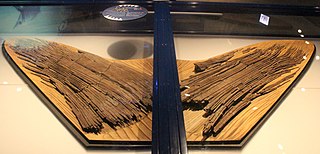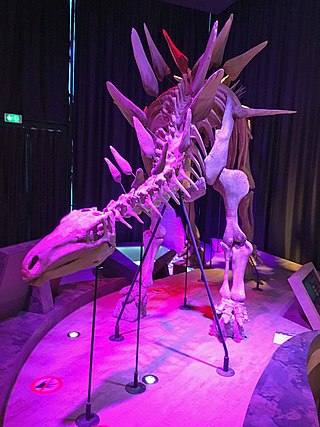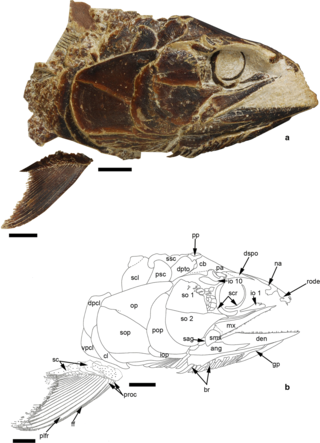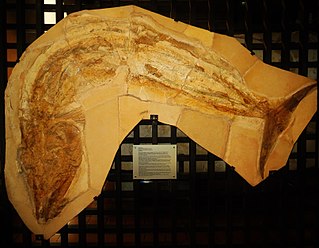
The Oxford Clay is a Jurassic marine sedimentary rock formation underlying much of southeast England, from as far west as Dorset and as far north as Yorkshire. The Oxford Clay Formation dates to the Jurassic, specifically, the Callovian and Oxfordian ages, and comprises two main facies. The lower facies comprises the Peterborough Member, a fossiliferous organic-rich mudstone. This facies and its rocks are commonly known as lower Oxford Clay. The upper facies comprises the middle Oxford Clay, the Stewartby Member, and the upper Oxford Clay, the Weymouth Member. The upper facies is a fossil poor assemblage of calcareous mudstones.

Leedsichthys is an extinct genus of pachycormid fish that lived in the oceans of the Middle to Late Jurassic. It is the largest ray-finned fish, and amongst the largest fish known to have ever existed.

Lexovisaurus is a genus of stegosaur from mid-to-Late Jurassic Europe, 165.7-164.7 mya. Fossils of limb bones and armor fragments have been found in middle to late Jurassic-aged strata of England and France.

Anaxyelidae is a family of incense cedar wood wasps in the order Hymenoptera. It contains only one living genus, Syntexis, which has only a single species, native to Western North America. Fossils of the family extend back to the Middle Jurassic, belonging to over a dozen extinct genera, with a particularly high diversity during the Early Cretaceous. Syntexis lay eggs in the sapwood of conifers, preferring recently burnt wood.
Peloneustes is a genus of pliosaurid plesiosaur from the Middle Jurassic of England. Its remains are known from the Peterborough Member of the Oxford Clay Formation, which is Callovian in age. It was originally described as a species of Plesiosaurus by palaeontologist Harry Govier Seeley in 1869, before being given its own genus by naturalist Richard Lydekker in 1889. While many species have been assigned to Peloneustes, P. philarchus is currently the only one still considered valid, with the others moved to different genera, considered nomina dubia, or synonymised with P. philarchus. Some of the material formerly assigned to P. evansi have since been reassigned to "Pliosaurus" andrewsi. Peloneustes is known from many specimens, including some very complete material.

Simolestes is an extinct pliosaurid genus that lived in the Middle to Late Jurassic. The type specimen, NHMUK PV R 3319 is an almost complete but crushed skeleton diagnostic to Simolestes vorax, dating back to the Callovian of the Oxford Clay formation, England. The genus might also be known from the Tithonian Bhuj Formation of India (S.indicus), however the referral of this species to Simolestes is dubious. S.keileni from France was moved to the new genus Lorrainosaurus in 2023.

Pachycormus is an extinct genus of pachycormiform ray-finned fish known from the Early Jurassic of Europe. The type species P. macropterus was first named as a species of Elops by Henri Marie Ducrotay de Blainville in 1818, it was placed into the newly named genus Pachycormus by Louis Agassiz in 1833. Fossils have been found in marine deposits from France, Germany and England. Pachycormus has recently been considered monotypic, only containing P.macropterus, with other species considered junior synonyms of the former, though this has subsequently been questioned. Pachycormus has generally been considered basal among Pachycormiformes, with a recent phylogeny finding it to be the second most basal pachycormiform after Euthynotus. It grew up to 1 m (3.5 ft) in length. The teeth are short and designed for grasping. Its ecology has been interpreted as that of a generalist predator. Stomach contents indicate that its diet included cephalopods, and small fish, including juvenile Pachycormus. One particular specimen shows that it died because of swallowing an ammonite too large for its size, and the ammonite itself was only shortly digested just before the fish's death.

Pachycormiformes is an extinct order of marine ray-finned fish known from the Early Jurassic to the end of the Cretaceous. It only includes a single family, Pachycormidae. They were characterized by having serrated pectoral fins, reduced pelvic fins and a bony rostrum. Pachycormiformes are morphologically diverse, containing both tuna and swordfish-like carnivorous forms, as well as edentulous suspension-feeding forms.

The Marnes de Dives is a geological formation in Normandy, France. It dates back to the upper part of the Callovian stage of the Middle Jurassic. And is partially equivalent to the Oxford Clay in England. It predominantly consists of ooidal marl, rich in pyrite and lignite, interbedded with thin limestone horizons. It is best exposed at the base of the Falaises des Vaches Noires as well as the foreshore at low tide. It is known for its fossils, notably those of ammonites, marine crocodiles and fragmentary remains of dinosaurs, mostly theropods.

Euthynotus is an extinct genus of prehistoric bony fish that lived during the early Toarcian stage of the Early Jurassic epoch. It is generally considered the basalmost pachycormiform.

Asthenocormus is an extinct genus of large marine pachycormiform ray-finned fish. It contains a single species, A. titanius. A member of the edentulous suspension feeding clade within the Pachycormiformes, fossils have been found in the Upper Jurassic plattenkalks of Bavaria, Germany.

Orthocormus is an extinct genus of prehistoric pachycormiform bony fish. It is known from three species found in Late Jurassic (Kimmeridgian) aged plattenkalk deposits in Bavaria, Germany. The species "Hypsocormus" tenuirostris Woodward 1889 from the late Middle Jurassic (Callovian) Oxford Clay is not closely related to the type species of Hypsocormus, and is more closely related to Orthocormus + Protosphyraena, and thus has sometimes been referred to in open nomenclature as Orthocormus? tenuirostris. The species of Orthocormus reached over a metre in length, and are thought to have been pelagic predators.

Bonnerichthys is a genus of fossil fishes within the family Pachycormidae that lived during the Coniacian to Maastrichtian stage of the Late Cretaceous. Fossil remains of this taxon were first described from the Smoky Hill Member of the Niobrara Chalk Formation of Kansas, and additional material was later reported from the Pierre Shale, Mooreville Chalk, Demopolis Chalk, Wenonah Formation, and Moreno Formation, among other localities. It grew to at least 5 metres (16 ft) in total body length, substantially less than the related Leedsichthys from the Jurassic which likely grew up to 16.5 metres (54 ft).
Rhinconichthys is an extinct genus of bony fish which existed during the Cenomanian stage of the Late Cretaceous.

Tyrannoneustes is an extinct genus of geosaurine metriorhynchid crocodyliform from the Callovian stage Oxford Clay Formation of England and the Marnes de Dives of France. It contains a single species, Tyrannoneustes lythrodectikos, meaning "blood-biting tyrant swimmer".

Sam Giles is a palaeobiologist and Professor in Vertebrate Palaeontology at the University of Birmingham. Her research combines modern imaging with fossils to understand the evolution of life, in particular that of early fish, and in 2015 "rewrote" the vertebrate family tree. She was a 2017 L'Oréal-UNESCO Rising Star and won the 2019 Geological Society of London Lyell Fund.
This list of fossil fishes described in 2019 is a list of new taxa of jawless vertebrates, placoderms, acanthodians, fossil cartilaginous fishes, bony fishes, and other fishes of every kind that were described during the year 2019, as well as other significant discoveries and events related to paleoichthyology that occurred in 2019.

Pseudoasthenocormus is an extinct genus of ray-finned fish belonging to the family Pachycormidae. It contains one species, P. retrodorsalis. It lived during the upper Jurassic and its fossil remains have been found in Germany.
Australopachycormus is an extinct genus of marine pachycormiform fish. It is only known from the type species, A. hurleyi, from the Early Cretaceous (Albian) Toolebuc Formation of Queensland, Australia. Like the related Protosphyraena, it possessed an elongated rostrum. Some sources have recovered it as a potential junior synonym of Protosphyraena, although more research is necessary.

"Pliosaurus" andrewsi is an extinct species of pliosaurid plesiosaurs that lived during the Callovian stage of the Middle Jurassic, in what is now England. The only known fossils of this taxon were discovered in the Peterborough Member of the Oxford Clay Formation. Other attributed specimens have been discovered in various corners of Eurasia, but these are currently seen as indeterminate or coming from other taxa. The taxonomic history of this animal is quite complex, because several of its fossils were attributed to different genera of pliosaurids, before being concretely named and described in 1960 by Lambert Beverly Tarlo as a species of Pliosaurus. However, although the taxon was found to be valid, subsequent revisions found that it is not part of this genus, and therefore a taxonomic revision must be carried out on this species.














